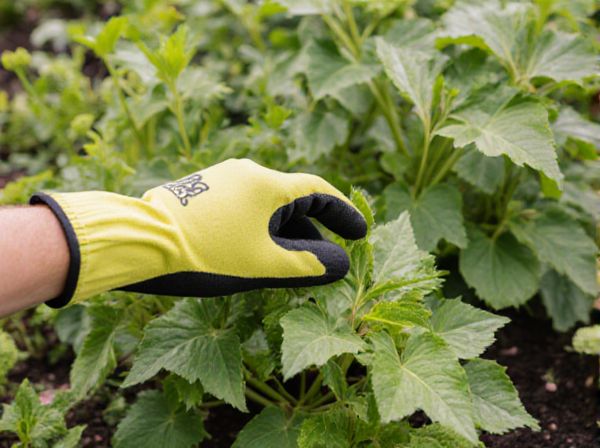
Foliar feeding vs Soil feeding Illustration
Foliar feeding delivers nutrients directly to plant leaves, enabling rapid absorption and quick correction of micronutrient deficiencies. Soil feeding provides nutrients to the root zone, supporting sustained growth and enhancing soil fertility over time. Combining both methods optimizes nutrient uptake and improves overall plant health and yield.
Table of Comparison
| Aspect | Foliar Feeding | Soil Feeding |
|---|---|---|
| Application Method | Sprayed directly onto leaves | Applied to the soil around the plant |
| Absorption | Absorbed through leaf stomata and cuticle | Uptake through roots |
| Nutrient Delivery Speed | Rapid nutrient absorption (hours to days) | Slower uptake (days to weeks) |
| Effectiveness | Effective for micronutrients and trace elements | Better for macronutrients and overall soil health |
| Frequency | Requires frequent applications | Less frequent due to longer nutrient release |
| Environmental Impact | Minimized nutrient runoff | Higher risk of leaching and runoff |
| Best Use | Correcting nutrient deficiencies quickly | Promoting long-term soil fertility |
| Limitations | Not effective during heavy rain or extreme heat | Dependent on soil conditions and microbial activity |
Understanding Foliar Feeding and Soil Feeding
Foliar feeding delivers nutrients directly to plant leaves, enabling rapid absorption of essential elements such as nitrogen, potassium, and micronutrients, enhancing nutrient efficiency and addressing deficiencies faster than traditional soil feeding. Soil feeding involves the application of fertilizers to the soil, promoting root absorption and improving overall soil fertility by increasing nutrient availability and microbial activity. Understanding the distinct nutrient uptake mechanisms and environmental conditions impacting foliar and soil feeding optimizes fertilizer application strategies for improved crop growth and yield.
Key Differences Between Foliar and Soil Fertilization
Foliar feeding delivers nutrients directly through plant leaves, enabling rapid absorption and immediate correction of deficiencies, while soil feeding provides nutrients via the root system, supporting long-term plant growth and soil health. Foliar application is ideal for quick nutrient uptake and targeted treatment, particularly for micronutrients, whereas soil feeding offers a broader nutrient supply essential for overall root development and microbial activity. The choice between foliar and soil fertilization depends on crop type, nutrient requirements, and environmental conditions influencing nutrient availability and uptake efficiency.
How Foliar Feeding Works in Garden Plants
Foliar feeding involves spraying nutrient-rich solutions directly onto plant leaves, allowing for rapid absorption through stomata and epidermal cells. This method bypasses soil limitations such as nutrient lockup or poor root uptake, providing immediate nourishment to plants. Foliar feeding is especially effective for delivering micronutrients like iron, zinc, and manganese, enhancing overall plant health and growth in gardens.
Advantages of Foliar Feeding
Foliar feeding delivers essential nutrients directly to plant leaves, enabling rapid absorption and immediate correction of nutrient deficiencies compared to soil feeding. It enhances nutrient efficiency by bypassing soil-related issues such as nutrient lock-up and poor root uptake. This method improves plant stress resistance and overall growth, especially in conditions where soil nutrient availability is limited.
How Soil Feeding Supports Plant Health
Soil feeding supplies essential nutrients directly to the root zone, enhancing nutrient uptake efficiency and improving soil structure for better root development. It promotes beneficial microbial activity, which helps convert organic matter into accessible nutrients, boosting plant resilience against diseases. Consistent soil feeding ensures long-term nutrient availability, supporting sustained plant growth and overall health.
Benefits of Soil Fertilization
Soil fertilization enhances plant nutrient absorption by delivering essential minerals directly to the root zone, promoting robust root development and long-term soil health. It improves soil structure, water retention, and microbial activity, which collectively support sustained plant growth and resilience. Unlike foliar feeding, soil fertilization provides a gradual nutrient release, ensuring a steady supply of macro and micronutrients vital for crop productivity.
Situations Best for Foliar Feeding
Foliar feeding is most effective in situations where nutrient deficiencies need to be corrected rapidly, such as during critical growth stages or when root uptake is impaired by soil conditions like compaction or salinity. It is ideal for delivering micronutrients and trace elements directly to plant leaves, ensuring quick absorption and immediate nutrient availability. This method complements soil feeding in cases of drought stress, root damage, or when quick correction of nutrient imbalances is crucial for optimal crop yield.
When to Choose Soil Feeding for Your Garden
Soil feeding is ideal for establishing long-term nutrient availability, particularly in gardens with poor soil structure or low organic matter content. Choosing soil feeding ensures root uptake of essential macronutrients like nitrogen, phosphorus, and potassium, which supports sustained plant growth. It is especially beneficial during early growth stages or when planting heavy feeders such as tomatoes and corn.
Combining Foliar and Soil Feeding Strategies
Combining foliar feeding and soil feeding strategies enhances nutrient uptake efficiency by targeting both leaf surfaces and root zones, ensuring rapid absorption and sustained nourishment. Foliar feeding delivers micronutrients directly to plant tissues, correcting deficiencies quickly, while soil feeding supports root development and long-term nutrient availability. Integrating these methods maximizes crop yield, improves plant health, and optimizes fertilizer use efficiency in various farming systems.
Choosing the Right Fertilization Method for Garden Success
Foliar feeding delivers nutrients directly to plant leaves, allowing rapid absorption and quick correction of nutrient deficiencies, ideal for immediate plant recovery. Soil feeding enhances root development and provides long-term nutrient availability, supporting sustained plant growth in well-prepared soil. Selecting the right fertilization method depends on garden goals, plant type, and nutrient needs, often combining both approaches for optimal results.
Foliar feeding vs Soil feeding Infographic

 gardendif.com
gardendif.com